Porous BiVO4/Boron-Doped Diamond Heterojunction Photoanode with Enhanced Photoelectrochemical Activity
Abstract
:1. Introduction
2. Results and Discussion
2.1. Morphological Characterization
2.2. Crystal Phase and Element Composition
2.3. Electronic Structures
2.4. Photoelectrochemical and Electrochemical Performance
2.5. Possible Mechanism
3. Experimental Section
3.1. Synthesis of Materials
3.2. Characterizations
3.3. PEC and EC Measurements
3.4. DFT Calculations
4. Conclusions
Supplementary Materials
Author Contributions
Funding
Institutional Review Board Statement
Informed Consent Statement
Data Availability Statement
Conflicts of Interest
Sample Availability
References
- Kahng, S.; Kim, J.H. Heterojunction photoanode of SnO2 and Mo-Doped BiVO4 for boosting photoelectrochemical performance and tetracycline hydrochloride degradation. Chemosphere 2022, 291, 132800. [Google Scholar] [CrossRef]
- Zhang, Y.; Lv, H.; Zhang, Z.; Wang, L.; Wu, X.; Xu, H. Stable unbiased photo-electrochemical overall water splitting exceeding 3% efficiency via covalent triazine framework/metal oxide hybrid photoelectrodes. Adv. Mater. 2021, 33, 2008264. [Google Scholar] [CrossRef]
- Wang, H.; Zhang, L.; Chen, Z.; Hu, J.; Li, S.; Wang, Z.; Liu, J.; Wang, X. Semiconductor heterojunction photocatalysts: Design, construction, and photocatalytic performances. Chem. Soc. Rev. 2014, 43, 5234–5244. [Google Scholar] [CrossRef]
- Jian, Z.; Yang, N.; Vogel, M.; Zhou, Z.; Zhao, G.; Kienitz, P.; Schulte, A.; Schönherr, H.; Jiao, T.; Zhang, W.; et al. Tunable photo-electrochemistry of patterned TiO2/BDD heterojunctions. Small. Methods. 2020, 4, 2000257. [Google Scholar] [CrossRef]
- Terashima, C.; Hishinuma, R.; Roy, N.; Sugiyama, Y.; Latthe, S.S.; Nakata, K.; Kondo, T.; Yuasa, M.; Fujishima, A. Charge separation in TiO2/BDD heterojunction thin film for enhanced photoelectrochemical performance. ACS Appl. Mater. Interfaces 2016, 8, 1583–1588. [Google Scholar] [CrossRef]
- Lips, S.; Waldvogel, S.R. Use of boron-doped diamond electrodes in electro-organic synthesis. ChemElectroChem 2019, 6, 1649–1660. [Google Scholar] [CrossRef]
- Yang, N.; Yu, S.; MacPherson, J.V.; Einaga, Y.; Zhao, H.; Zhao, G.; Swain, G.M.; Jiang, X. Conductive diamond: Synthesis, properties, and electrochemical applications. Chem. Soc. Rev. 2019, 48, 157–204. [Google Scholar] [CrossRef]
- Alulema-Pullupaxi, P.; Fernández, L.; Debut, A.; Santacruz, C.P.; Villacis, W.; Fierro, C.; Espinoza-Montero, P.J. Photoelectrocatalytic degradation of glyphosate on titanium dioxide synthesized by sol-gel/spin-coating on boron doped diamond (TiO2/BDD) as a photoanode. Chemosphere 2021, 278, 130488. [Google Scholar] [CrossRef]
- Yao, Y.; Sang, D.; Duan, S.; Wang, Q.; Liu, C. Review on the properties of boron-doped diamond and one-dimensional-metal-oxide based p-n heterojunction optoelectronic. Molecules 2021, 26, 71. [Google Scholar] [CrossRef]
- Huang, J.; Meng, A.; Zhang, Z.; Xiao, S.; Guo, X.; Wu, X.; Huang, S.; Ma, G.; Han, P.; He, B. Enhanced visible-light-driven photoelectrochemical activity in nitrogen-doped TiO2/boron-doped diamond heterojunction electrodes. ACS Appl. Energy Mater. 2022, 5, 7144–7156. [Google Scholar] [CrossRef]
- Suzuki, N.; Okazaki, A.; Kuriyama, H.; Serizawa, I.; Hirami, Y.; Hara, A.; Hirano, Y.; Nakabayashi, Y.; Roy, N.; Terashima, C. Synergetic effect in water treatment with mesoporous TiO2/BDD hybrid electrode. RSC Adv. 2020, 10, 1793–1798. [Google Scholar] [CrossRef]
- Behúl, M.; Vojs, M.; Marton, M.; Michniak, P.; Mikolášek, M.; Kurniawan, M.; Honig, H.L.; Zyabkin, D.V.; Ramirez, M.O.; Redhammer, R.A. Nanostructured boron doped diamond enhancing the photoelectrochemical performance of TiO2/BDD heterojunction anodes. Vacuum 2020, 171, 109006. [Google Scholar] [CrossRef]
- Fan, J.; Shi, H.; Xiao, H.; Zhao, G. Double-layer 3D macro-mesoporous metal oxide modified boron-doped diamond with enhanced photoelectrochemical performance. ACS Appl. Mater. Interfaces 2016, 8, 28306–28315. [Google Scholar] [CrossRef]
- Kim, T.W.; Choi, K.S. Nanoporous BiVO4 photoanodes with dual-layer oxygen evolution catalysts for solar water splitting. Science 2014, 343, 990–994. [Google Scholar] [CrossRef]
- Liu, J.; Li, J.; Li, Y.; Guo, J.; Xu, S.M.; Zhang, R.; Shao, M. Photoelectrochemical water splitting coupled with degradation of organic pollutants enhanced by surface and interface engineering of BiVO4 photoanode. Appl. Catal. B 2020, 278, 119268. [Google Scholar] [CrossRef]
- Chen, M.; Liu, Y.; Li, C.; Li, A.; Chang, X.; Liu, W.; Sun, Y.; Wang, T.; Gong, J. Spatial control of cocatalysts and elimination of interfacial defects towards efficient and robust CIGS photocathodes for solar water splitting. Energy Environ. Sci. 2018, 11, 2025–2034. [Google Scholar] [CrossRef]
- Huang, Q.; Qiu, Y.; Luo, H.; Yuan, Y.; Li, X.; Wang, Z.; Mai, W. P-Type NiO modified BiVO4 photoanodes with enhanced charge separation and solar water oxidation kinetics. Mater. Lett. 2019, 249, 128–131. [Google Scholar] [CrossRef]
- Pan, Q.; Zhang, C.; Xiong, Y.; Mi, Q.; Li, D.; Zou, L.; Huang, Q.; Zou, Z.; Yang, H. Boosting charge separation and transfer by plasmon-enhanced MoS2/BiVO4 p-n heterojunction composite for efficient photoelectrochemical water splitting. ACS Sustain. Chem. Eng. 2018, 6, 6378–6387. [Google Scholar] [CrossRef]
- Wang, S.; He, T.; Yun, J.H.; Hu, Y.; Xiao, M.; Du, A.; Wang, L. New iron-cobalt oxide catalysts promoting BiVO4 films for photoelectrochemical water splitting. Adv. Funct. Mater. 2018, 28, 1802685. [Google Scholar] [CrossRef]
- Li, Y.; Li, X.; Wang, X.T.; Jian, L.J.; Abdallah, N.I.M.; Dong, X.F.; Wang, C.W. P-n heterostructured design of decahedral NiS/BiVO4 with efficient charge separation for enhanced photodegradation of organic dyes. Colloids Surf. A 2021, 608, 125565. [Google Scholar] [CrossRef]
- Ma, M.; Lei, E.; Zhao, D.; Xin, Y.; Wu, X.; Meng, Y.; Liu, Z. The p-n heterojunction of BiVO4/Cu2O was decorated by plasma AgNPs for efficient photoelectrochemical degradation of Rhodamine B. Colloids Surf. A 2022, 633, 127834. [Google Scholar] [CrossRef]
- Wang, S.; Zhao, L.; Huang, W.; Zhao, H.; Chen, J.; Cai, Q.; Jiang, X.; Lu, C.; Shi, W. Solvothermal synthesis of CoO/BiVO4 p-n heterojunction with micro-nano spherical structure for enhanced visible light photocatalytic activity towards degradation of tetracycline. Mater. Res. Bull. 2021, 135, 111161. [Google Scholar] [CrossRef]
- Zhang, Y.; Bu, Y.; Wang, L.; Ao, J.P. Regulation of the photogenerated carrier transfer process during photoelectrochemical water splitting: A review. Green Energy Environ. 2021, 6, 479–495. [Google Scholar] [CrossRef]
- Lu, Y.; Yang, Y.; Fan, X.; Li, Y.; Zhou, D.; Cai, B.; Wang, L.; Fan, K.; Zhang, K. Boosting charge transport in BiVO4 photoanode for solar water oxidation. Adv. Mater. 2022, 34, 2108178. [Google Scholar] [CrossRef]
- Tan, H.L.; Amal, R.; Ng, Y.H. Alternative strategies in improving the photocatalytic and photoelectrochemical activities of visible light-driven BiVO4: A review. J. Mater. Chem. A 2017, 5, 16498–16521. [Google Scholar] [CrossRef]
- Wang, S.; Liu, B.; Wang, X.; Zhang, Y.; Huang, W. Nanoporous MoO3-x/BiVO4 photoanodes promoting charge separation for efficient photoelectrochemical water splitting. Nano Res. 2022, 15, 7026–7033. [Google Scholar] [CrossRef]
- Baker, K.; Zhitomirsky, I. A biomimetic strategy for the fabrication of micro- and nanodiamond composite films. Micro 2022, 2, 154–163. [Google Scholar] [CrossRef]
- Wang, Y.; Chen, D.; Zhang, J.; Balogun, M.S.; Wang, P.; Tong, Y.; Huang, Y. Charge relays via dual carbon-actions on nanostructured BiVO4 for high performance photoelectrochemical water splitting. Adv. Funct. Mater. 2022, 32, 2112738. [Google Scholar] [CrossRef]
- Wang, R.; Lin, F.; Niu, G.; Su, J.; Yan, X.; Wei, Q.; Wang, W.; Wang, K.; Yu, C.; Wang, H.X. Reducing threading dislocations of single-crystal diamond via in situ tungsten incorporation. Materials 2022, 15, 444. [Google Scholar] [CrossRef]
- Kshetri, Y.K.; Chaudhary, B.; Kamiyama, T.; Kim, T.H.; Rosei, F.; Lee, S.W. Determination of ferroelastic phase transition temperature in BiVO4 by Raman spectroscopy. Mater. Lett. 2021, 291, 129519. [Google Scholar] [CrossRef]
- Byun, S.; Jung, G.; Moon, S.Y.; Kim, B.; Park, J.Y.; Jeon, S.; Nam, S.W.; Shin, B. Compositional engineering of solution-processed BiVO4 photoanodes toward highly efficient photoelectrochemical water oxidation. Nano Energy 2018, 43, 244–252. [Google Scholar] [CrossRef]
- Frost, R.L.; Henry, D.A.; Weier, M.L.; Martens, W. Raman spectroscopy of three polymorphs of BiVO4: Clinobisvanite, dreyerite and pucherite, with comparisons to (VO4) 3-bearing minerals: Namibite, pottsite and schumacherite. J. Raman Spectrosc. 2006, 37, 722–732. [Google Scholar] [CrossRef]
- Jin, S.; Ma, X.; Pan, J.; Zhu, C.; Saji, S.E.; Hu, J.; Xu, X.; Sun, L.; Yin, Z. Oxygen vacancies activating surface reactivity to favor charge separation and transfer in nanoporous BiVO4 photoanodes. Appl. Catal. B 2021, 281, 119477. [Google Scholar] [CrossRef]
- Wang, S.; Chen, P.; Yun, J.H.; Hu, Y.; Wang, L. An electrochemically treated BiVO4 photoanode for efficient photoelectro-chemical water splitting. Angew. Chem. 2017, 129, 8620–8624. [Google Scholar] [CrossRef]
- Ju, S.; Jun, J.; Son, S.; Park, J.; Lim, H.; Kim, W.; Chae, D.; Lee, H. Structured BiVO4 photoanode fabricated via sputtering for large areas and enhanced photoelectrochemical performance. ACS Sustain. Chem. Eng. 2020, 8, 17923–17932. [Google Scholar] [CrossRef]
- Wang, S.; He, T.; Chen, P.; Du, A.; Ostrikov, K.; Huang, W.; Wang, L. In situ formation of oxygen vacancies achieving near-complete charge separation in planar BiVO4 photoanodes. Adv. Mater. 2020, 32, 2001385. [Google Scholar] [CrossRef]
- Liu, S.; Sun, J.; Ren, G.; Meng, X. Vacancy-engineered bismuth-based semiconductor with enhanced photocatalytic activity: A review. Mater. Sci. Semicond. Process. 2022, 137, 106230. [Google Scholar] [CrossRef]
- Liang, Z.Y.; Huang, W.-J.; Huang, R.K.; Peng, J.H.; Wang, Y.; Yan, G.Y. Modulating charge migration and motion behaviors via discretely decorating BiVO4 on porous g-C3N4 for boosting multifarious photoredox conversion. Appl. Surf. Sci. 2022, 589, 153004. [Google Scholar] [CrossRef]
- Hermans, Y.; Murcia-López, S.; Klein, A.; Van De Krol, R.; Andreu, T.; Morante, J.R.; Toupance, T.; Jaegermann, W. Analysis of the interfacial characteristics of BiVO4/metal oxide heterostructures and its implication on their junction properties. Phys. Chem. Chem. Phys. 2019, 21, 5086–5096. [Google Scholar] [CrossRef]
- Venkatesan, R.; Velumani, S.; Ordon, K.; Makowska-Janusik, M.; Corbel, G.; Kassiba, A. Nanostructured bismuth vanadate (BiVO4) thin films for efficient visible light photocatalysis. Mater. Chem. Phys. 2018, 205, 325–333. [Google Scholar] [CrossRef]
- He, B.; Ng, T.W.; Lo, M.F.; Lee, C.S.; Zhang, W.J. Surface transfer doping of cubic boron nitride films by MoO3 and tetrafluoro-tetracyanoquinodimethane (F4-TCNQ). ACS Appl. Mater. Interfaces 2015, 7, 9851–9857. [Google Scholar] [CrossRef]
- Pan, J.B.; Wang, B.H.; Wang, J.B.; Ding, H.Z.; Zhou, W.; Liu, X.; Zhang, J.R.; Shen, S.; Guo, J.K.; Chen, L.; et al. Activity and stability boosting of an oxygen-vacancy-rich BiVO4 photoanode by NiFe-MOFs thin layer for water oxidation. Angew. Chem. Int. Ed. 2021, 60, 1433–1440. [Google Scholar] [CrossRef]
- Pelissari, M.R.d.S.; Azevedo Neto, N.F.; Camargo, L.P.; Dall’Antonia, L.H. Characterization and photo-induced electro-catalytic evaluation for BiVO4 films obtained by the SILAR process. Electrocatalysis 2021, 12, 211–224. [Google Scholar] [CrossRef]
- Ning, X.; Huang, J.; Li, L.; Gu, Y.; Jia, S.; Qiu, R.; Li, S.; Kim, B.H. Homostructured rutile TiO2 nanotree arrays thin film electrodes with nitrogen doping for enhanced photoelectrochemical performance. J. Mater. Sci. Mater. Electron. 2019, 30, 16030–16040. [Google Scholar] [CrossRef]
- He, Y.; Wang, P.; Zhu, J.; Yang, Y.; Liu, Y.; Chen, M.; Cao, D.; Yan, X. Synergistical dual strategies based on in situ-converted heterojunction and reduction-induced surface oxygen vacancy for enhanced photoelectrochemical performance of TiO2. ACS Appl. Mater. Interfaces 2019, 11, 37322–37329. [Google Scholar] [CrossRef]
- Thalluri, S.M.; Rojas, R.M.; Rivera, O.D.; Hernández, S.; Russo, N.; Rodil, S.E. Chemically induced porosity on BiVO4 films produced by double magnetron sputtering to enhance the photo-electrochemical response. Phys. Chem. Chem. Phys. 2015, 17, 17821–17827. [Google Scholar] [CrossRef]
- Kim, J.H.; Lee, J.S. Elaborately modified BiVO4 photoanodes for solar water splitting. Adv. Mater. 2019, 31, 1806938. [Google Scholar] [CrossRef]
- Wang, J.T.; Cai, Y.L.; Liu, X.J.; Zhang, X.D.; Cai, F.Y.; Cao, H.L.; Zhong, Z.; Li, Y.F.; Lü, J. Unveiling the visible–light–driven photodegradation pathway and products toxicity of tetracycline in the system of Pt/BiVO4 nanosheets. J. Hazard. Mater. 2022, 424, 127596. [Google Scholar] [CrossRef]
- Cheng, L.; Jiang, T.; Yan, K.; Gong, J.; Zhang, J. A dual-cathode photoelectrocatalysis-electroenzymatic catalysis system by coupling BiVO4 photoanode with Hemin/Cu and Carbon cloth cathodes for degradation of tetracycline. Electrochim. Acta 2019, 298, 561–569. [Google Scholar] [CrossRef]
- Yi, X.; Zhu, J.; Yan, Y.; Cheng, H.; Xu, W. Removal of tetracycline hydrochloride (Tch) in simulated wastewater by zero-valent iron with ultrasonic irradiation (Us-Ziv). Pol. J. Environ. Stud. 2020, 30, 903–916. [Google Scholar] [CrossRef]
- Liu, D.; Li, H.; Gao, R.; Zhao, Q.; Yang, Z.; Gao, X.; Wang, Z.; Zhang, F.; Wu, W. Enhanced visible light photoelectrocatalytic degradation of tetracycline hydrochloride by I and P Co-doped TiO2 photoelectrode. J. Hazard. Mater. 2021, 404, 124309. [Google Scholar] [CrossRef]
- Nareejun, W.; Ponchio, C. Solar energy materials and solar cells novel photoelectrocatalytic/solar cell improvement for organic dye degradation based on simple dip coating WO3/BiVO4 photoanode electrode. Sol. Energy Mater. Sol. Cells 2020, 212, 110556. [Google Scholar] [CrossRef]
- Chi, Z.; Zhao, J.; Zhang, Y.; Yu, H.; Yu, H. Coral-like WO3/BiVO4 photoanode constructed via morphology and facet engineering for antibiotic wastewater detoxification and hydrogen recovery. Chem. Eng. J. 2022, 428, 131817. [Google Scholar] [CrossRef]
- Ahmad, M.F.; Suzuki, M.; Abe, T.; Nagai, K. Enhanced oxidation power in photoelectrocatalysis based on a micrometer-localized positive potential in a terrace hetero p-n junction. NPG Asia Mater. 2018, 10, 630–641. [Google Scholar] [CrossRef]
- Takeuchi, D.; Ri, S.G.; Kato, H.; Nebel, C.E.; Yamasaki, S. Negative electron affinity on hydrogen terminated diamond. Phys. Status Solidi A Appl. Mater. Sci. 2005, 202, 2098–2103. [Google Scholar] [CrossRef]
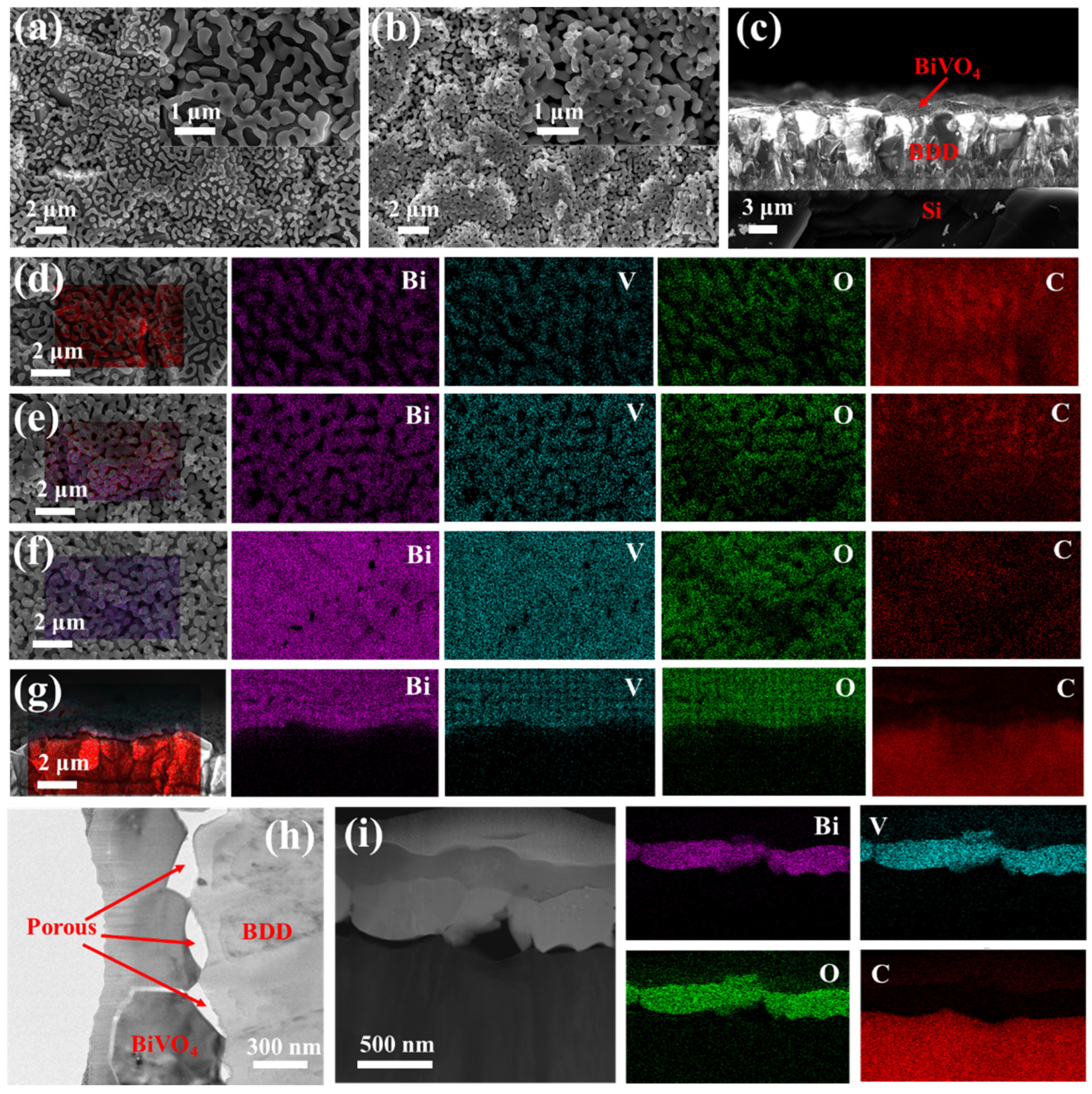
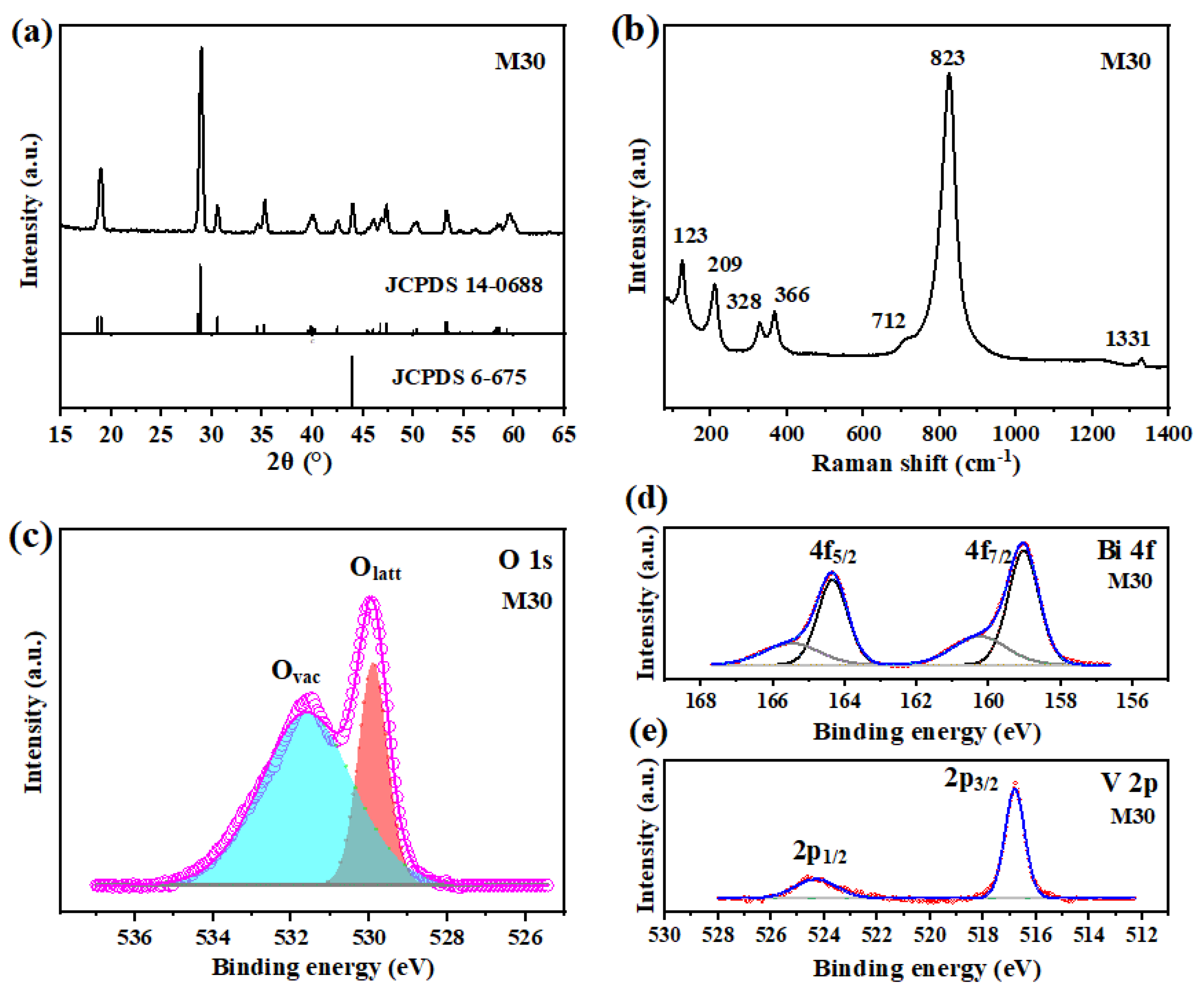
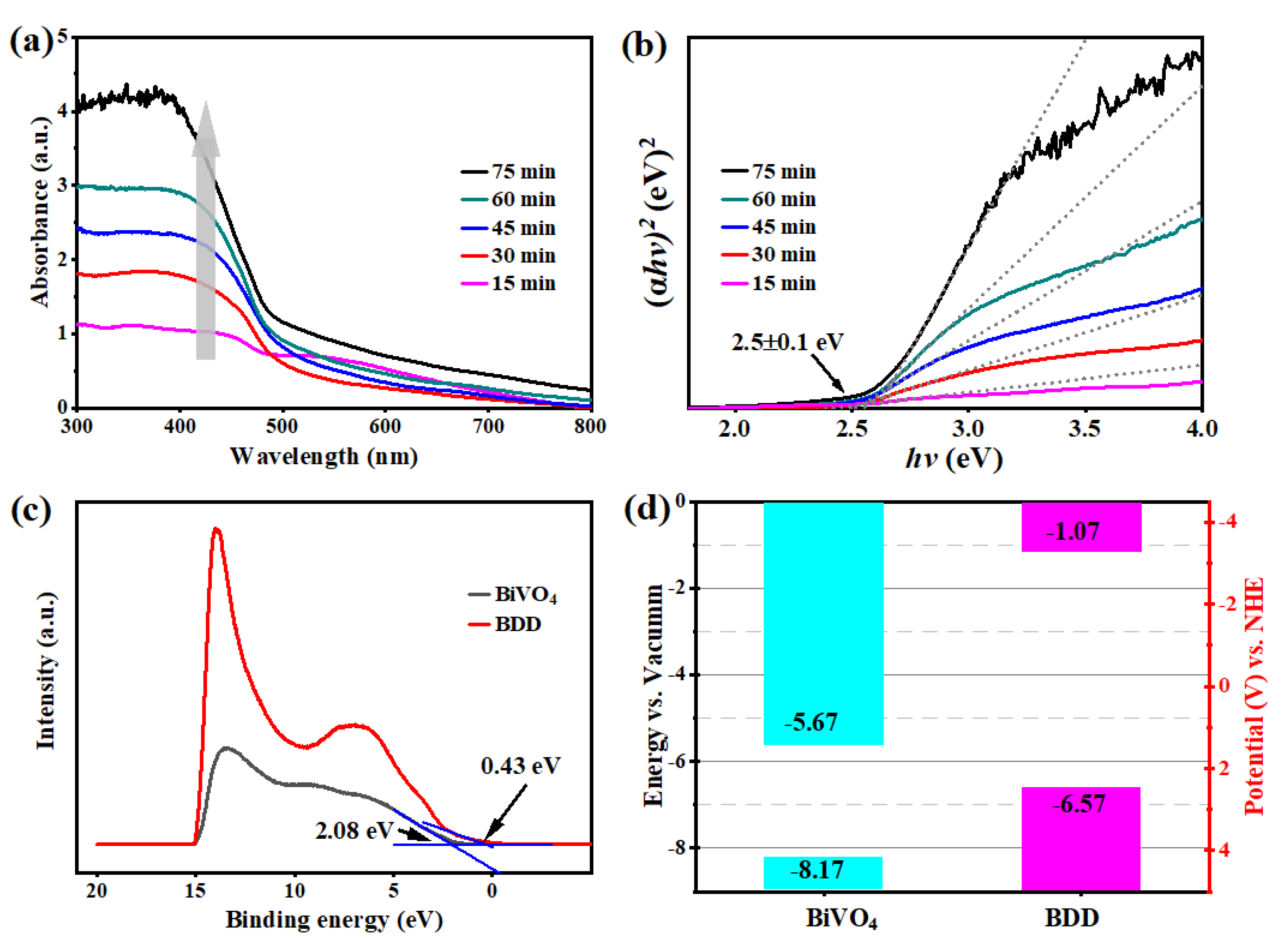
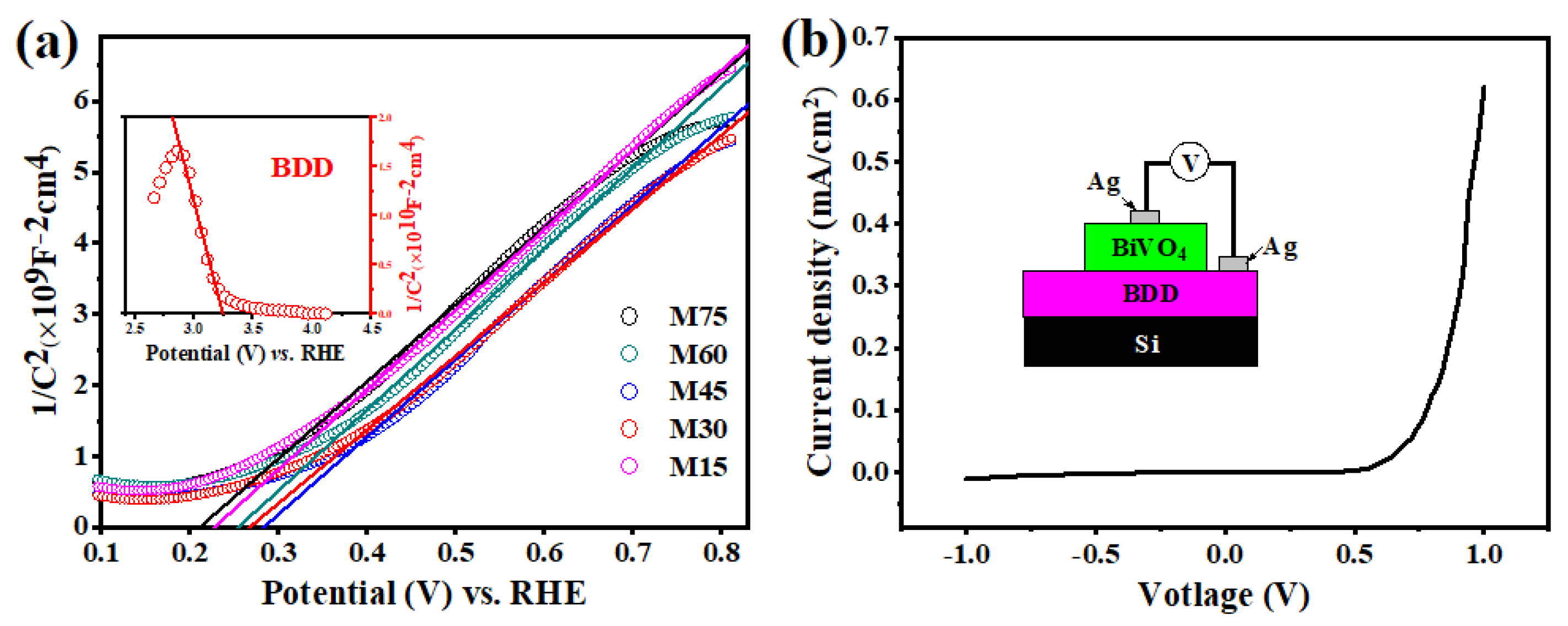


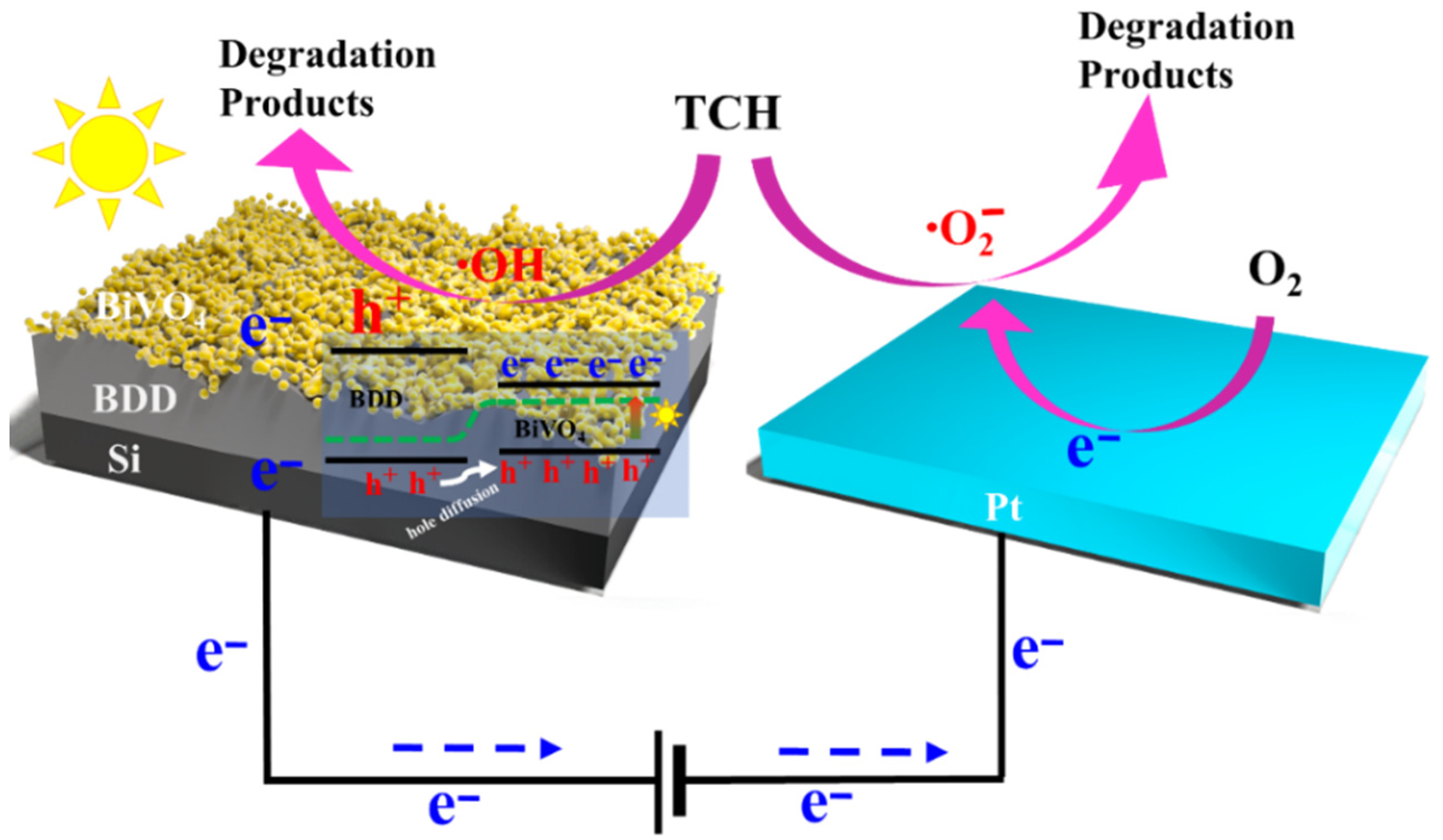
| Photoanodes | Experimental Conditions | Degradation Activity | Years and Ref. |
|---|---|---|---|
| TiO2/BDD | Glyphosate (50 mg/L); UVC light lamp (9 W and λ = 254 nm); 5 mA/cm2. | Removal: 99.5% (5 h); k = 0.0081 min−1 | 2021 [8] |
| SnO2/Mo: BiVO4 | TCH (5 mg/L); AM 1.5 G; 1.23 VRHE. | Removal: 82.1% (120 min); k = 0.00149 min−1 | 2022 [1] |
| F-BiVO4@NiFe-LDH | TCH (20 mg/L); Simulated solar light (100 mW cm−2); 0.5 V vs. Ag/AgCl. | Removal: 86% (2 h); k = 0.0156 min−1. | 2020 [15] |
| Patterned TiO2/BDD | MO (50 mg/L); Simulated solar light (100 mW cm−2); 2.5 V vs. Ag/AgCl. | Removal: 100% (4 h). | 2020 [4] |
| BiVO4/Ag/Cu2O | RhB (5 mg/L); AM 1.5 G; 1.2 VRHE. | Removal: 86% (120 min); k = 0.01586 min−1. | 2022 [21] |
| WO3/BiVO4 | RhB (5 mg/L); Visible-light; 1.0 V vs. Ag/AgCl. | Removal: 93% (3 h); | 2020 [48] |
| Coral-like WO3/BiVO4 photoanode | Sulfamethoxazole (20 mg/L); AM 1.5 G; 1.5 V vs. Ag/AgCl. | Removal: 82.1% (120 min) | 2022 [49] |
| Porous BiVO4/BDD | TCH (20 mg/L); AM 1.5; 1.0 VRHE. | Removal: 45.1% (10 min); k = 0.057 min−1 | This work |
Publisher’s Note: MDPI stays neutral with regard to jurisdictional claims in published maps and institutional affiliations. |
© 2022 by the authors. Licensee MDPI, Basel, Switzerland. This article is an open access article distributed under the terms and conditions of the Creative Commons Attribution (CC BY) license (https://creativecommons.org/licenses/by/4.0/).
Share and Cite
Huang, J.; Meng, A.; Zhang, Z.; Ma, G.; Long, Y.; Li, X.; Han, P.; He, B. Porous BiVO4/Boron-Doped Diamond Heterojunction Photoanode with Enhanced Photoelectrochemical Activity. Molecules 2022, 27, 5218. https://doi.org/10.3390/molecules27165218
Huang J, Meng A, Zhang Z, Ma G, Long Y, Li X, Han P, He B. Porous BiVO4/Boron-Doped Diamond Heterojunction Photoanode with Enhanced Photoelectrochemical Activity. Molecules. 2022; 27(16):5218. https://doi.org/10.3390/molecules27165218
Chicago/Turabian StyleHuang, Jiangtao, Aiyun Meng, Zongyan Zhang, Guanjie Ma, Yuhao Long, Xingyu Li, Peigang Han, and Bin He. 2022. "Porous BiVO4/Boron-Doped Diamond Heterojunction Photoanode with Enhanced Photoelectrochemical Activity" Molecules 27, no. 16: 5218. https://doi.org/10.3390/molecules27165218
APA StyleHuang, J., Meng, A., Zhang, Z., Ma, G., Long, Y., Li, X., Han, P., & He, B. (2022). Porous BiVO4/Boron-Doped Diamond Heterojunction Photoanode with Enhanced Photoelectrochemical Activity. Molecules, 27(16), 5218. https://doi.org/10.3390/molecules27165218






